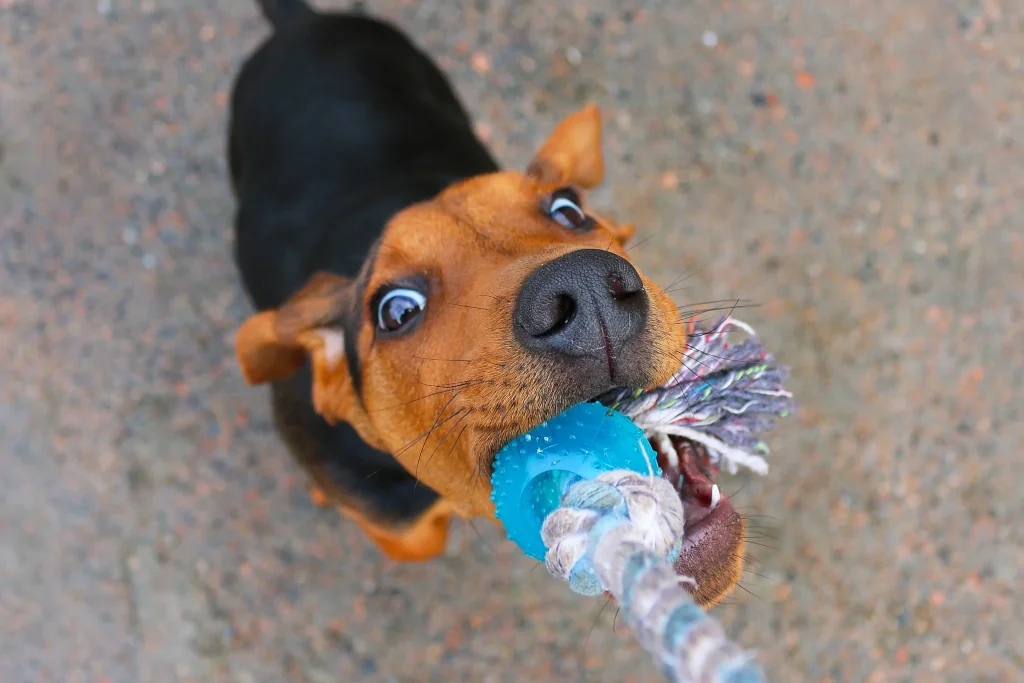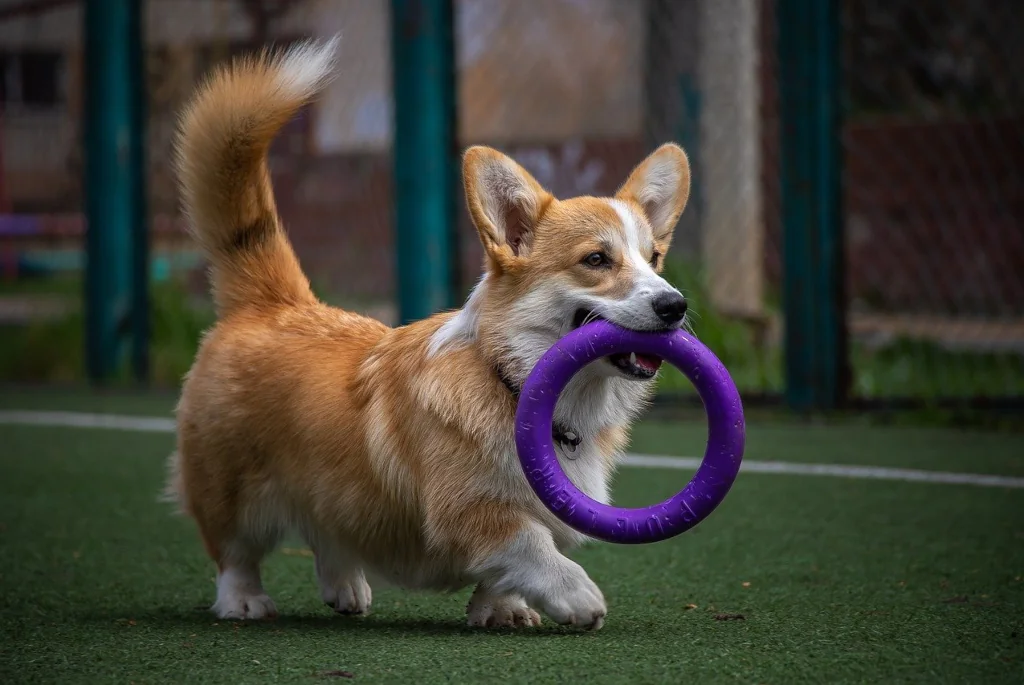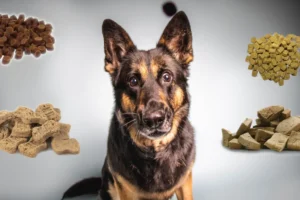Disclosure: We may earn a commission from helpful, relevant links in our content. No cost to you. See our privacy policy.
Got a lively rover that chews through training toys faster than lightning?
Or perhaps you’re scratching your head, wondering why your dog seems to prefer your slippers over that fancy toy you just bought? Finding the perfect training toy for your dog is highly rewarding.
And it’s not rocket science – it just requires a little bit of canine insight, understanding, and yes, patience. Together, let’s pick training toys that your dog will adore and will turn your training tasks into a breeze.

Factors to Consider When Choosing Dog Training Toys
Choosing the perfect training toy for your dog isn’t as simple as picking the most colorful or the loudest one off the shelf. Several factors come into play that can significantly influence not just your dog’s interaction with the toy, but also its effectiveness during training sessions.
- Dog’s Age. Just like human children, puppies have different toy needs compared to adult dogs. Soft, chewable toys are better suited for teething puppies, while more durable and challenging toys can be ideal for older dogs.
- Size and Texture. The toy’s size and texture should be appropriate for your dog’s mouth. Small toys might pose a choking hazard for large dogs, while big toys might be difficult for smaller breeds to enjoy.
- Dog’s Personality. Some dogs love squeaky toys, while others might prefer a quiet plushie. Knowing your dog’s preferences can help you choose a toy they’ll love and engage with.
- Purpose of the Toy. If you’re looking for a toy to assist with training, consider toys that can hold treats or ones that can be used for fetch or tug-of-war.
- Safety. This is non-negotiable. Ensure the toy is made from non-toxic materials and doesn’t have parts that can easily break off and become a choking risk.
Remember, the key to choosing the right training toy lies in understanding your dog’s unique preferences and needs. When chosen correctly, a training toy can be more than just a plaything – it can be a valuable ally in your training journey.
Types of Training Toys and How to Choose the Best
Fetch Toys
Fetch toys are an excellent option for training because they motivate dogs to retrieve, which naturally stimulates their prey drive and helps develop their attention and focus.

Balls and frisbees, such as the Chuckit! Ultra Ball, are a great choice. This ball, in particular, is made from durable material and bounces unpredictably, adding a fun challenge to your dog’s playtime.
When selecting a fetch toy, make sure it’s made from durable material and is the right size for your dog to pick up without difficulty.
My golden Charlie…
As for my dear Charlie, his love for fetch is unparalleled. One day, we were out in the park with his favorite tennis ball. Charlie, the enthusiastic golden retriever he is, chased it with such gusto that he ended up stealing the spotlight at a nearby kid’s football game. Remembering those chuckles still brings a grin to my face!
Chew Toys
Chew toys can be a valuable tool for training, especially for puppies that are teething. They help divert the chewing behavior towards appropriate items, thus saving your precious furniture.
When choosing a chew toy, always consider its toughness and texture. For example, hard chew toys are suitable for aggressive chewers, while softer ones are appropriate for puppies.

The KONG Classic Dog Toy is excellent for puppies that are teething and adult dogs alike. KONG toys are known for their toughness and can handle even the most aggressive chewers, keeping your precious furniture safe from destructive chewing.
Always check for any small parts that could pose a choking hazard.
Interactive Toys
Interactive toys, such as puzzles or toys with hidden treats, stimulate your dog’s cognitive abilities. They can keep your dog busy and mentally challenged, making them great tools for training. Select one based on your dog’s intelligence and curiosity levels.

The Outward Hound Hide-A-Squirrel Puzzle Toy is a great choice as it stimulates your dog’s cognitive abilities and is filled with hiding spots for squirrel-shaped squeaky toys. It will keep your dog mentally challenged and engaged.
A tip from my years of dog training:
Start with simple puzzle toys and gradually increase the difficulty to keep your pooch interested and challenged. There’s no need to get a complicated toy only for your dog to be confused and frustrated by it.
Tug Toys

Tug toys like the Mammoth Flossy Chews Rope Tug are fantastic for teaching commands like ‘drop it’ or ‘leave it’. It’s a fun game that can strengthen your bond with your dog and give them a good workout at the same time.
Look for tug toys made of strong material that can withstand your dog’s strength. However, remember to set clear rules during tug games to prevent any aggressive behavior.
Suggested reading: Teach your dog to ‘drop it’ or to ‘leave it‘
Scented Toys
Scented toys can be used for training dogs in tracking and search-and-rescue jobs. These toys appeal to a dog’s natural sense of smell and can be used to play hide-and-seek games that improve their problem-solving skills.

When picking a scented toy, choose one with a scent that’s appealing but not overpowering. The Benebone Bacon Flavor Wishbone Chew Toy is great for training dogs in tracking. This toy’s appealing bacon scent can keep your dog engaged and improve their problem-solving skills during a lively game of hide-and-seek.
Choosing the right training toy might require some trial and error, but by considering your dog’s size, breed, personality, and training goals, you can select a toy that will not only entertain them but also aid significantly in their training. Our recommended picks serve as a great starting point to make this process easier.
Match Your Toy to Your Training Objective
To sum it up, different types of toys can support various training objectives. Here’s a quick guide that matches different training purposes with suitable toys. This handy guide can help you make the best choice for your pup:
Table: Best Toys for Different Training Purposes
| Training Purpose | Suitable Toy |
|---|---|
| Fetch games | Balls, Frisbees |
| Tug games | Rope toys, Tug toys |
| Puzzle-solving | Treat-dispensing toys, Puzzle toys |
| Chew control | Rubber chew toys, Dental toys |
| Agility | Tunnels, Hurdles |
| Obedience | Interactive toys, Training dummies |
| Distraction management | Durable chew toys, Interactive toys |
With this table, you can easily match your dog’s training needs to the appropriate toy. It’s an excellent tool to guide your decision when you’re in the pet store aisle or shopping online.
Remember, a toy that matches your training goal and keeps your dog engaged will make your training sessions more effective and fun.
Do Dogs Have a Favorite Toy?
Absolutely, dogs can have a favorite toy. Much like humans, dogs have preferences, too.
They might prefer a particular toy due to its texture, size, shape, or even smell. Some dogs might have a fondness for a certain toy because of the memories associated with it.
It’s not uncommon to find a dog carrying around a cherished chew toy like a toddler with a favorite blanket. By observing your dog’s play behavior, you can discern which toy they fancy the most. If a specific toy keeps them engaged for longer, that’s probably their favorite!

How to Choose Durable Toys Your Dog Won’t Destroy
Now onto the big question – how do we find toys that survive the loving attention of our dogs, especially the power chewers like Charlie? Well, it’s not as complicated as you may think.
Material Matters. The first factor to consider is the material. Toys made from hard rubber or durable nylon tend to be more resilient. Avoid toys made from thin plastic or stuffed toys if your dog is an aggressive chewer.
Size is Significant. Choosing the right size is equally important. A toy that’s too small can be a choking hazard, while a toy that’s too large might not be as engaging.
Design Makes a Difference. Opt for toys with a solid construction, without any small pieces that can easily be chewed off and swallowed.
Stick to Reputable Brands. Lastly, always purchase toys from trusted brands that prioritize pet safety. They may cost a little more, but they’re generally made to higher quality standards.
Sam’s durable chew toy…
To give you an example, my dog Sam had a particular love for squeaky toys. Unfortunately, his enthusiasm often resulted in a pile of destroyed toys. That was until I found a durable, squeaky rubber toy designed for power chewers.
Sam’s eyes sparkled as the toy squeaked under his grip, but this time, the squeaker lived to see another day. Since that day, I’ve learned that investing in high-quality, durable toys saves both money and worry in the long run. Now, Sam enjoys his squeaky toy, and I enjoy the peace of mind, knowing it’s built to last.
Smart Toys: What Are They and Are They Worth It?
Smart toys, also known as interactive or puzzle toys, are designed to stimulate your dog’s cognitive abilities. They often involve hidden treats that your dog has to figure out how to access, encouraging problem-solving skills.
In my experience, these toys are worth every penny. They keep dogs entertained for hours and provide mental stimulation that regular toys can’t. Plus, they are great for slowing down fast eaters and providing indoor exercise.
Two fantastic smart toys are the:
These toys require your pooch to flip, pull, and slide various compartments to uncover hidden treats, providing both physical activity and mental stimulation.
Remember to choose a toy that matches your dog’s intelligence level; a too complicated toy might frustrate them, while an overly simple one might not hold their interest.
How to Teach Your Dog to Differentiate Between Toys
Teaching your dog to differentiate between toys can be a fun and rewarding task. Here’s a tip that’s often overlooked: start by naming each toy.
During playtime, use the toy’s name repeatedly so your dog begins to associate the word with the specific toy. Then, test their knowledge by asking them to fetch the toy by its name.
Patience is key here – it might take several weeks for your dog to catch on. My untrained dog, Charlie, was initially confused, but with consistent training, he began to understand the difference between his “ball” and “rope”.
Wrapping up this tail-wagging adventure of ours, we’ve seen how the right toys and the right techniques can elevate your dog’s training experience. It’s not just about obedience but nurturing a relationship of understanding and mutual respect with your furry friend.
So next time you’re looking at your dog’s toy box, remember: you’re not just choosing a toy, you’re choosing a tool that can shape your dog’s growth and development. Happy training!
FAQs
Do I Need Different Toys for Different Training Goals?
Yes, different training goals will require different toys. For instance, fetch toys can help train your dog to come when called, while puzzle toys help stimulate their problem-solving skills.
Is There a Perfect Number of Toys for Your Dog?
There’s no definitive answer as to how many toys to get for your dog, as it depends on your dog’s preferences and play habits. One or two toys at a time are generally sufficient, and it’s a good idea to have a variety of toys available to keep your dog engaged and stimulated.
Are All Dog Training Toys Safe for My Dog?
While most dog training toys are designed with safety in mind, the suitability of a toy also depends on your dog’s size, breed, and chewing habits. Always check the toy for small parts that might pose a choking hazard and regularly inspect it for wear and tear.
Alex, a passionate animal lover, has experience in training and understanding animal behavior. As a proud pet parent to two dogs and three cats, he founded AnimalReport.net to share insights from animal experts and expand his knowledge of the animal kingdom.




